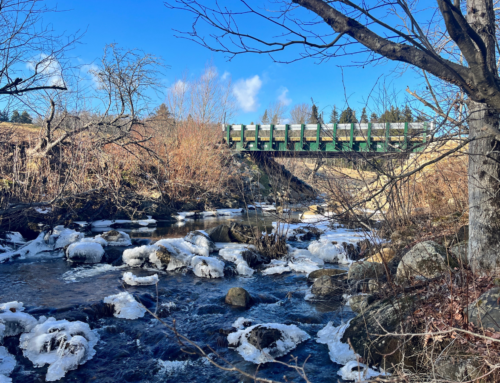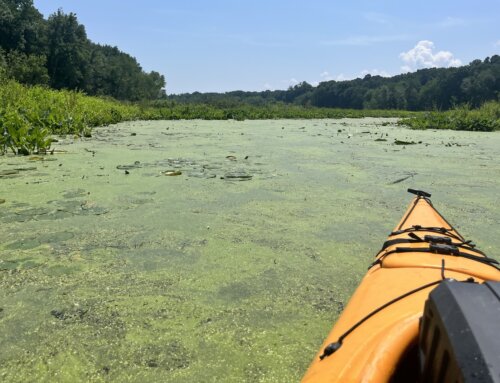An important statewide, intense, and lengthy process to protect the waters of Vermont just ended. It started 18 months ago with the passage of Act 64 (the VT Clean Water Act of 2015) with its requirement to rewrite the Accepted Agricultural Practices into new and more protective standards called the Required Agricultural Practices (RAPs). Unless you are in the farming or river advocacy communities, you may have missed the whole thing.
The EPA requirement that Vermont establish a new cleanup plan for Lake Champlain, to reduce the discharge of phosphorous pollution into Lake Champlain, kicked the effort to clean up our waters into high gear at both the community and legislative levels. Excess phosphorus leads to algae blooms that are harmful to fish and other aquatic critters that live in the water as well as to anyone who likes to recreate in or near the water. Of course, Lake Champlain is not the only waterbody that needs help in meeting the Vermont Water Quality Standards (WQS), so the legislative effort quickly encompassed all watersheds, statewide.
In response to EPA requirements, Vermont analyzed the contributions of excess nutrients to the Lake. We found that agriculture contributes up to 65% of the phosphorous to Lake Champlain with the balance coming from forestlands, sewage treatment plants, unpaved roads, and river instability. We do not have anywhere near as thorough an analysis on the Connecticut River, Lake Memphremagog, or the Battenkill watersheds but unless land uses are significantly different, the percentages of contribution by sector in the three other watersheds would be much the same.
Although the talk has been about Lake Champlain, there are problems in the other watersheds. Both Lake Memphremagog and the Connecticut River terminus, Long Island Sound face nutrient loading problems just as Lake Champlain does. They too are not meeting all the Vermont WQS and EPA required both to develop and/or implement cleanup plans. The Connecticut River cleanup mandate affects New Hampshire’s rivers as well as those in Vermont but Vermont does not write water law for New Hampshire.
When you look at the Champlain analysis, the clear message is that agriculture is the largest single source of nutrient loading and hence Vermont’s new law focuses on both regulations that are more stringent and increased resources for agriculture to reduce their contribution. Under the terms of the new Vermont law and the settlement with EPA, all sectors Agriculture, forestry, towns, development, and town roads are required to play their part in protecting our waters.
The legislative mantra during development and approval of the new law became “All In” so ALL towns are eligible for help to meet the higher best management practices (BMPs) for their roads, infrastructure, development, and wastewater treatment facilities. ALL farms are eligible for matching funds to better steward their land and all municipalities and farms are eligible for technical assistance to meet the new road standards and the farm RAPs.
One of the principal tactics in Act 64 aimed at reducing farm nutrient pollution is the development of new requirements under the RAPs for more protective farming practices. As with most changes in the way we do things, not all are happy with the new requirements.
Farmers voiced concerns that the draft rule is too restrictive and will cost more money during a time of low milk prices. Some even argued we are off in the wrong direction entirely and what really needs to happen is to shift how we grow things, away from traditional practices into regenerative agriculture. Regenerative agriculture is a story that is too long to tell here and now but it would, suffice it to say, entail radical changes in farming.
Clean water advocates maintain that the changes do not go far enough, claiming the proposed 25-foot buffer width is inadequate, and that there is no requirement for undisturbed natural vegetated riparian zones that are the first line of defense sitting between our waters and the crop growing in the fields and animal production areas. They are especially concerned that farms can harvest, fertilize, or graze their cows in these buffer zones. They are concerned that the requirement to fence animals out of streams is not sufficiently strict nor well enough defined to be effective.
Despite the disagreements, the public hearings were civil and the lengthy process has been inclusive, with the Agency of Agriculture Food and Markets (AAFM) providing numerous public meetings through three rounds of hearings where AAFM gathered both verbal and written comments from interested citizens. Participation was so robust that to ensure AAFM heard from all interested parties, AAFM requested and the legislature approved extending the timeline for completing the process.
We reached a hiatus in the forward motion in the adoption process on July 7 when the comment period closed. AAFM must take the draft of their proposed rule and after reviewing the public input, modify it or not using their best judgement. Thirty days from the seventh, they will send the proposed rule to the Legislative Committee on Administrative Rules where, in 45 days, eight legislators must decide if the rule meets the intent of the VT Clean Water Act. The adoption of the most important rewrite of agricultural practices in 20 years is not over yet, so stay tuned.







